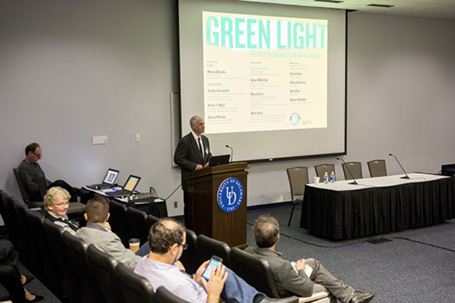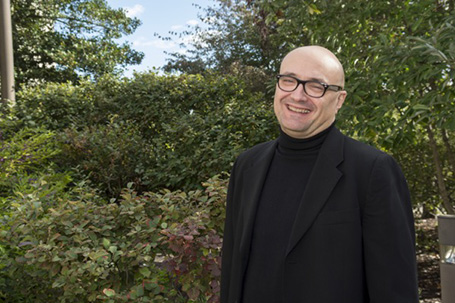‘Green Light’ symposium : Seeing the light
Symposium at UD examines artificial illumination from diverse perspectives

From art, architecture and history to physics and materials science, speakers at the University of Delaware?s ?Green Light? symposium on Friday, Oct. 16, brought a variety of perspectives and areas of expertise to the subject of artificial illumination.
Light is an element of ?cosmic significance,? part of virtually every creation story ever told, Sandy Isenstadt told the audience assembled in Clayton Hall for the daylong event. Isenstadt, professor of art history and director of UD?s Center for Material Culture Studies, provided a brief history of urban lighting in a talk titled ?Good Night.?
He teaches the history of modern architecture and is the co-editor of the 2015 book Cities of Light: Two Centuries of Urban Illumination, the first global overview of urban lighting. His current book project, The Architecture of Artificial Light, examines the novel luminous spaces introduced by electric lighting.
?Light today is so ubiquitous and expected [in industrialized areas] that we tend to forget ? how fantastic it is and the miraculous nature of artificial light,? Isenstadt said at the symposium. He spoke about the many past centuries in which artificial light was almost unchanged, provided by oil lamps and candles, and was also very expensive and therefore used sparingly.
All that changed with the introduction of gas and then electric lights, Isenstadt said. With that technology, municipalities began providing outdoor illumination, architects created structures that incorporated lighting, and U.S. cities competed to showcase their own versions of New York?s ?Great White Way.?
Today, he said, ?We are at an amazing junction? of new lighting technologies and an artistic interest in using light for innovative design.
Some of those innovative design ideas were described in the symposium?s keynote address, ?Create the Livable City? by Marco Bevolo, a consultant who has worked with Philips Lighting?s continuing city.people.light project since it began in 1996. The international project holds workshops that include architects, artists, lighting designers and city planners to brainstorm ideas for lighting projects that maximize sustainability and make future cities more livable.
He showed slides and described some of the hundreds of ideas that have resulted from the project, including buildings designed so that the interior light spills out onto adjacent sidewalks and roadways, recycling private illumination into public lighting.

Other design ideas Bevolo discussed were ?Media Windows,? in which video is projected onto windows for passers-by to see, and a European plaza in which a dramatic beam of blue light provides the focal point where a statue once stood. In Poland, he said, workshop participants came up with the idea of lighting some of the underpasses located throughout cities to make them usable at night.
?These places are pitch-dark, and citizens don?t go there because it?s dangerous,? Bevolo said. As soon as lighting was added to one, families arrived and children spontaneously turned the space into a playground, creating ?the most touching moment of my life,? he said.
About the symposium
In introducing the ?Green Light? symposium, Perry Chapman, professor and associate chair of art history at UD, noted that the department will mark its 50th anniversary in 2016 at a time when the arts and humanities are increasingly intersecting with the sciences.
?We need to look to a future? in which such collaborations continue and expand, she said.
George Watson, dean of the College of Arts and Sciences, also emphasized the connections among arts, humanities and sciences in his welcoming remarks. A physicist, Watson said he worked as a laser spectroscopist, seeking optically based devices to replace electronic ones. As such, he said, light played an important part in his own research career.
Watson also thanked the symposium?s supporters and speakers, and particularly recognized Carol Nigro and her committee of volunteers for their ?tireless efforts? in organizing the event. Nigro, who received a master?s degree in 1997 and a doctorate in 2009, has collaborated with UD faculty, alumni and supporters to form the Friends of Art History, a fundraising and advocacy group that promotes the study of the visual arts at UD.
Other speakers at the symposium were Peter Y. Ngai, vice president of OLED (organic light emitting diode) lighting at Acuity Brands; Giana Phelan, director of business development of OLEDWorks; Ricardo Rivera, a UD alumnus, visual artist, filmmaker and creator of the Nightscape installation on view through Oct. 31 at Longwood Gardens; Anne Militello, founder of Vortex Lighting in Los Angeles and head of lighting programs at the California Institute of the Arts; Don Slater, co-founder of the Configuring Light/Staging the Social research group at the London School of Economics; and Matt Doty, associate professor of materials science and engineering at UD.
The final session of the day was a panel discussion among those responsible for executing Philadelphia?s June 5th Memorial Park, a project to honor the six lives lost in the collapse of the Salvation Army store in 2013.
?Green Light: Prospects in Lighting Design and Technology? is the second in ?Art and Science: Connections and Intersections,? a series of symposiums dedicated to the seamless connections between the visual arts and the sciences.
By examining topics that bind research in both the arts and sciences, the symposiums are part of UD?s efforts to familiarize a diverse audience from business, technology, the arts and academia, as well as alumni and friends of the University, with its interdisciplinary activities and its commitment to public humanities.
?Green Light? was a collaboration among the Department of Art History, the Center for Material Culture Studies, the Harker Interdisciplinary Science and Engineering Laboratory and the College of Engineering.
Funding was provided by UD?s Office of the Provost, the colleges of Arts and Sciences and of Engineering, the departments of Art History and of Art and Design, the Center for Material Culture Studies and the Interdisciplinary Humanities Research Center. Additional support was provided by ?Connections and Intersections? sponsor Penn Lighting Associates and by Digital Filaments.
